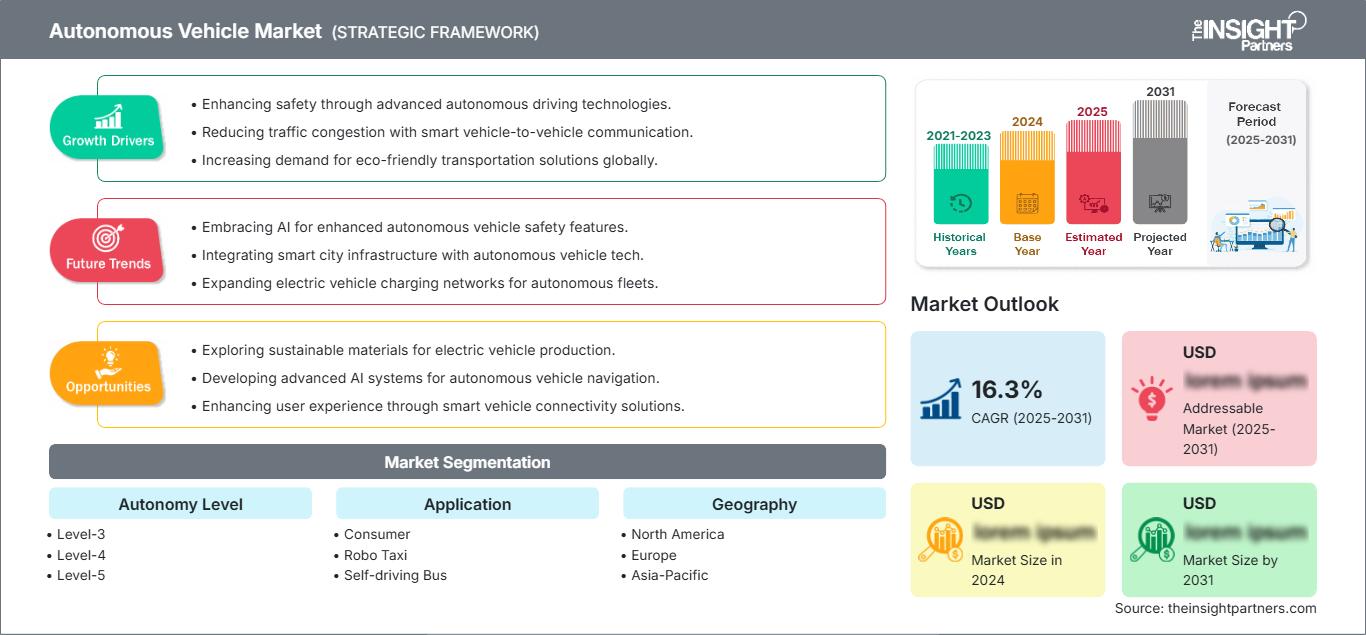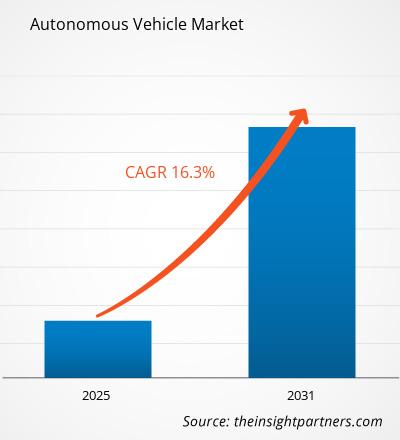Si prevede che il mercato dei veicoli autonomi registrerà un CAGR del 16,3% dal 2025 al 2031, con una dimensione del mercato in espansione da XX milioni di dollari nel 2024 a XX milioni di dollari entro il 2031.
Il rapporto è segmentato per livello di autonomia (Livello 3, Livello 4, Livello 5); applicazione (Consumer, Robo Taxi, Autobus a guida autonoma, Ride Hail, Ride Share). L'analisi globale è ulteriormente suddivisa a livello regionale e per i principali paesi. Il rapporto offre il valore in USD per l'analisi e i segmenti sopra indicati.
Scopo del rapporto
Il rapporto sul mercato dei veicoli autonomi di The Insight Partners mira a descrivere il panorama attuale e la crescita futura, i principali fattori trainanti, le sfide e le opportunità. Ciò fornirà spunti a vari stakeholder aziendali, come:
- Fornitori/produttori di tecnologia: per comprendere le dinamiche di mercato in evoluzione e conoscere le potenziali opportunità di crescita, consentendo loro di prendere decisioni strategiche informate.
- Investitori: per condurre un'analisi completa delle tendenze in merito al tasso di crescita del mercato, alle proiezioni finanziarie del mercato e alle opportunità esistenti lungo la catena del valore.
- Organismi di regolamentazione: per regolamentare le politiche e le attività di controllo nel mercato con l'obiettivo di ridurre al minimo gli abusi, preservare la fiducia degli investitori e sostenere l'integrità e la stabilità del mercato.
Segmentazione del mercato dei veicoli autonomi Livello di autonomia
- Livello 3
- Livello 4
- Livello 5
Applicazione
- Consumatore
- Taxi robotico
- Autobus a guida autonoma
- Ride Hail
- Ride Share
Potrai personalizzare gratuitamente qualsiasi rapporto, comprese parti di questo rapporto, o analisi a livello di paese, pacchetto dati Excel, oltre a usufruire di grandi offerte e sconti per start-up e università
Mercato dei veicoli autonomi: Approfondimenti strategici

- Ottieni le principali tendenze chiave del mercato di questo rapporto.Questo campione GRATUITO includerà l'analisi dei dati, che vanno dalle tendenze di mercato alle stime e alle previsioni.
Fattori trainanti della crescita del mercato dei veicoli autonomi
- Progressi tecnologici nell'intelligenza artificiale e nell'apprendimento automatico: il continuo progresso nelle tecnologie di intelligenza artificiale e apprendimento automatico sta trainando il mercato dei veicoli autonomi (AV). Questi progressi consentono ai veicoli autonomi di elaborare meglio i dati provenienti dai sensori, prendere decisioni in tempo reale e migliorare la sicurezza. L'intelligenza artificiale consente ai veicoli di interpretare l'ambiente circostante con crescente precisione, migliorando la navigazione, la prevenzione delle collisioni e la gestione del traffico. Con l'evoluzione di queste tecnologie, l'affidabilità delle auto a guida autonoma aumenta, favorendo una maggiore fiducia e accettazione da parte dei consumatori, accelerando la crescita del mercato.
- Maggiore attenzione alla sicurezza stradale e alla prevenzione degli incidenti: i veicoli autonomi sono destinati a ridurre gli errori umani, responsabili della maggior parte degli incidenti stradali. Sfruttando sensori, telecamere e algoritmi avanzati, i veicoli autonomi possono anticipare i pericoli e reagire più rapidamente dei conducenti umani. Questa promessa di ridurre significativamente gli incidenti e salvare vite umane ha catturato l'attenzione sia delle autorità di regolamentazione che dei consumatori. Governi e compagnie assicurative stanno supportando sempre di più la tecnologia dei veicoli autonomi per migliorare la sicurezza stradale, stimolando così la crescita del mercato.
- Supporto governativo e quadri normativi: i governi di tutto il mondo stanno investendo massicciamente nelle tecnologie dei veicoli autonomi per plasmare i futuri sistemi di trasporto. Politiche, sovvenzioni e incentivi vengono introdotti per incoraggiare lo sviluppo e la sperimentazione dei veicoli autonomi. Inoltre, gli enti di regolamentazione stanno lavorando attivamente per stabilire quadri che garantiscano sicurezza, sicurezza informatica e standard etici per le auto a guida autonoma. Questo sostegno governativo, insieme a chiare linee guida normative, rafforza la fiducia del mercato e accelera la diffusione dei veicoli autonomi sulle strade.
Trend futuri del mercato dei veicoli autonomi
- Ascesa dei veicoli elettrici autonomi: la convergenza tra veicoli elettrici (EV) e tecnologie di veicoli autonomi è una tendenza emergente. I veicoli elettrici, alimentati da energia pulita, si allineano alla spinta verso la sostenibilità e il trasporto ecologico. Con lo sviluppo di sistemi autonomi per i veicoli elettrici da parte delle case automobilistiche, la domanda di auto elettriche a guida autonoma è in aumento. Questa tendenza è incoraggiata dalle politiche ambientali, dalla preferenza dei consumatori per un trasporto ecosostenibile e dalla crescente efficienza dei costi dei veicoli elettrici. Si prevede che il passaggio ai veicoli autonomi elettrici determinerà una significativa espansione del mercato nei prossimi anni.
- Integrazione con la Mobility-as-a-Service (MaaS): un'altra tendenza che sta plasmando il mercato dei veicoli autonomi è la crescente integrazione dei veicoli autonomi con le piattaforme Mobility-as-a-Service (MaaS). I consumatori prediligono sempre più modelli di trasporto condivisi e on-demand, riducendo il possesso di auto e utilizzando i veicoli autonomi per il ride-hailing, i servizi navetta e la connettività dell'ultimo miglio. Le piattaforme MaaS combinano opzioni di trasporto, tra cui auto, autobus e biciclette a guida autonoma, in un unico servizio integrato. Questa tendenza sta contribuendo all'espansione dei veicoli autonomi come parte fondamentale dell'ecosistema del trasporto urbano.
Opportunità di mercato per i veicoli autonomi
- Sviluppo delle infrastrutture per i veicoli autonomi: la spinta globale verso le città intelligenti e le infrastrutture connesse offre significative opportunità per i veicoli autonomi. Sistemi stradali intelligenti con sensori avanzati, gestione del traffico e comunicazione veicolo-infrastruttura (V2I) possono migliorare la sicurezza e l'efficienza dei veicoli autonomi. Questi sviluppi creano un ambiente favorevole per l'implementazione dei veicoli autonomi e possono ridurre i costi operativi, migliorare le prestazioni e ridurre gli incidenti. Con gli investimenti governativi in infrastrutture intelligenti, il mercato dei veicoli autonomi è pronto per una rapida crescita.
- Partnership e collaborazioni nell'ecosistema dei veicoli autonomi: le partnership strategiche tra case automobilistiche, aziende tecnologiche e istituti di ricerca rappresentano una preziosa opportunità per accelerare l'innovazione dei veicoli autonomi. Le aziende del settore automobilistico e tecnologico possono sfruttare le rispettive competenze in materia di intelligenza artificiale, sensori, analisi dei dati e progettazione dei veicoli. Le collaborazioni possono guidare lo sviluppo di veicoli autonomi più sicuri, affidabili e convenienti. Questo approccio collaborativo promuove l'innovazione, accelera il lancio commerciale e aiuta le aziende a condividere l'onere finanziario dello sviluppo dei veicoli autonomi.
Approfondimenti regionali sul mercato dei veicoli autonomi
Le tendenze e i fattori regionali che influenzano il mercato dei veicoli autonomi durante il periodo di previsione sono stati ampiamente spiegati dagli analisti di The Insight Partners. Questa sezione analizza anche i segmenti e la geografia del mercato dei veicoli autonomi in Nord America, Europa, Asia-Pacifico, Medio Oriente e Africa, America meridionale e centrale.
Ambito del rapporto sul mercato dei veicoli autonomi
| Attributo del rapporto | Dettagli |
|---|---|
| Dimensioni del mercato in 2024 | US$ XX million |
| Dimensioni del mercato per 2031 | US$ XX Million |
| CAGR globale (2025 - 2031) | 16.3% |
| Dati storici | 2021-2023 |
| Periodo di previsione | 2025-2031 |
| Segmenti coperti |
By Livello di autonomia
|
| Regioni e paesi coperti | Nord America
|
| Leader di mercato e profili aziendali chiave |
|
Densità degli operatori del mercato dei veicoli autonomi: comprendere il suo impatto sulle dinamiche aziendali
Il mercato dei veicoli autonomi è in rapida crescita, trainato dalla crescente domanda degli utenti finali, dovuta a fattori quali l'evoluzione delle preferenze dei consumatori, i progressi tecnologici e una maggiore consapevolezza dei vantaggi del prodotto. Con l'aumento della domanda, le aziende stanno ampliando la propria offerta, innovando per soddisfare le esigenze dei consumatori e sfruttando le tendenze emergenti, alimentando ulteriormente la crescita del mercato.

- Ottieni il Mercato dei veicoli autonomi Panoramica dei principali attori chiave
Punti di forza
- Copertura completa: il rapporto analizza in modo esaustivo prodotti, servizi, tipologie e utenti finali del mercato dei veicoli autonomi, offrendo una panoramica olistica.
- Analisi degli esperti: il rapporto è redatto sulla base della conoscenza approfondita di esperti e analisti del settore.
- Informazioni aggiornate: il rapporto garantisce la pertinenza aziendale grazie alla copertura di informazioni e dati recenti.
- Opzioni di personalizzazione: questo rapporto può essere personalizzato per soddisfare le esigenze specifiche del cliente e adattarsi in modo appropriato alle strategie aziendali.
Il rapporto di ricerca sul mercato dei veicoli autonomi può quindi contribuire a guidare il percorso di decodificazione e comprensione dello scenario del settore e delle prospettive di crescita. Sebbene possano esserci alcune preoccupazioni valide, i vantaggi complessivi di questo rapporto tendono a superare gli svantaggi.
- Analisi storica (2 anni), anno base, previsione (7 anni) con CAGR
- Analisi PEST e SWOT
- Valore/volume delle dimensioni del mercato - Globale, Regionale, Nazionale
- Industria e panorama competitivo
- Set di dati Excel
Report recenti
Rapporti correlati
Testimonianze
Motivo dell'acquisto
- Processo decisionale informato
- Comprensione delle dinamiche di mercato
- Analisi competitiva
- Analisi dei clienti
- Previsioni di mercato
- Mitigazione del rischio
- Pianificazione strategica
- Giustificazione degli investimenti
- Identificazione dei mercati emergenti
- Miglioramento delle strategie di marketing
- Aumento dell'efficienza operativa
- Allineamento alle tendenze normative




















 Ottieni un campione gratuito per - Mercato dei veicoli autonomi
Ottieni un campione gratuito per - Mercato dei veicoli autonomi